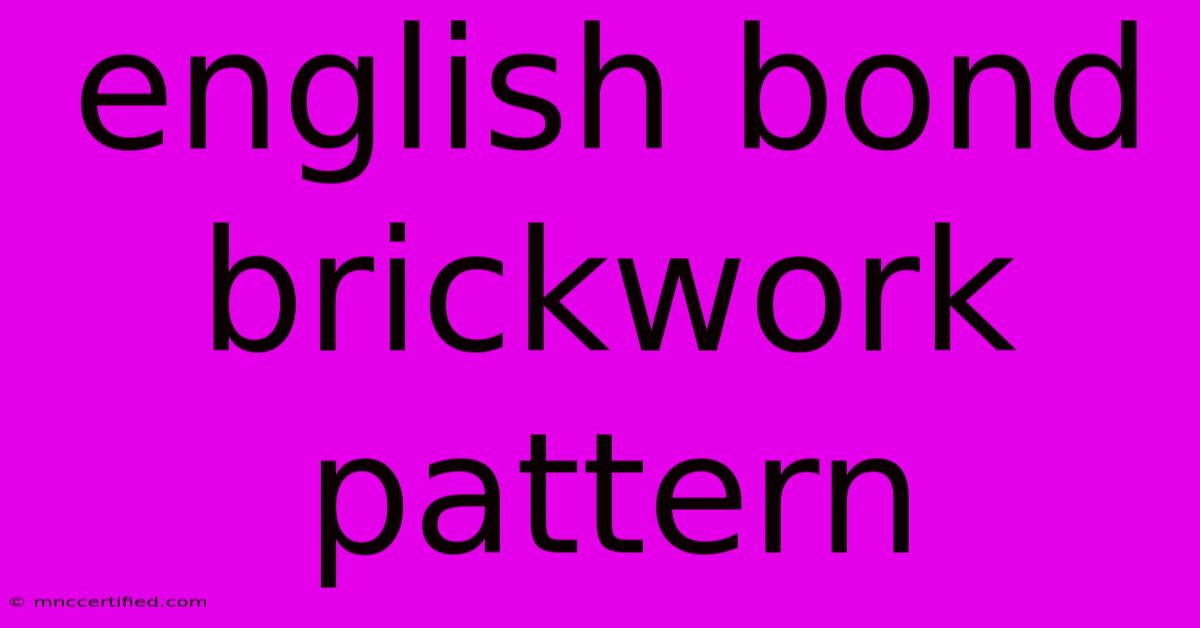English Bond Brickwork Pattern

Table of Contents
English Bond Brickwork Pattern: A Comprehensive Guide
The English bond, a classic and visually appealing bricklaying pattern, is a cornerstone of traditional brickwork. Understanding its construction, advantages, and variations is crucial for both aspiring bricklayers and those seeking to appreciate the artistry of brickwork. This comprehensive guide delves into the intricacies of the English bond, providing you with all the information you need.
What is English Bond Brickwork?
The English bond is characterized by its distinctive alternating pattern of headers (bricks laid with their short ends visible) and stretchers (bricks laid with their long sides visible). Each course (horizontal row) consists entirely of headers, followed by a course of stretchers, creating a strong and visually striking bond. This creates a strong, stable structure and a beautiful aesthetic often associated with traditional British architecture.
Key Characteristics of English Bond:
- Alternating Headers and Stretchers: The defining feature, creating a visually pleasing and structurally sound pattern.
- Header Courses: Entire courses composed solely of headers, usually laid in a slightly overlapping manner for strength.
- Stretcher Courses: Courses featuring only stretchers, meticulously aligned for a clean, even appearance.
- Queen Closers: Special half-bricks used to maintain the pattern at the ends of walls, ensuring a symmetrical finish. Mastering the use of queen closers is crucial for achieving a perfect English bond.
- Strength and Stability: The interlocking pattern of headers and stretchers provides exceptional structural integrity.
Advantages of Using English Bond
The English bond offers numerous benefits, making it a preferred choice for many building projects:
- High Structural Strength: The interlocking nature of the bricks significantly enhances the wall's load-bearing capacity. This makes it suitable for load-bearing walls in various building types.
- Aesthetic Appeal: The distinctive pattern creates a visually appealing and timeless finish. This classic look enhances the curb appeal of any property.
- Improved Weather Resistance: The overlapping headers provide a degree of protection against driving rain, contributing to better weather resistance.
- Versatility: It can be adapted to different brick sizes and shapes, accommodating various design requirements.
Variations of English Bond
While the standard English bond is well-defined, variations exist to cater to specific design needs and aesthetic preferences:
- English Garden Wall Bond: A variation commonly used for garden walls, featuring thinner bricks and a slightly less robust construction.
- Modified English Bond: This incorporates variations in the header and stretcher arrangement, offering a more contemporary aesthetic while retaining the core principles of the English bond. This often involves using different brick colors or sizes.
- English Cross Bond: A less common variation, involving the use of both headers and stretchers in the same course, arranged in a cross pattern.
Laying English Bond Brickwork: A Step-by-Step Guide
While a comprehensive guide to bricklaying is beyond this article's scope, understanding the basic steps is important. Remember, safety is paramount, always wear appropriate PPE (Personal Protective Equipment).
- Prepare the Foundation: A level and solid foundation is essential for a stable wall.
- Lay the First Course (Headers): Lay the first course of headers, ensuring they are level and properly aligned.
- Lay the Second Course (Stretchers): Lay the stretchers, ensuring they are properly bonded to the headers. Accurate spacing is crucial.
- Continue the Pattern: Repeat the header and stretcher courses, ensuring consistent alignment and bonding throughout the wall's construction.
- Use Queen Closers: Properly place queen closers at the ends of each course to maintain the pattern and structural integrity.
- Mortar Application: Apply mortar evenly to ensure proper bonding between bricks. Avoid excessive mortar, as this can weaken the structure and affect the aesthetic appeal.
SEO Considerations for Your English Bond Brickwork Article
To improve search engine visibility, consider these points:
- Keyword Optimization: Naturally integrate keywords like "English bond brickwork," "bricklaying patterns," "header," "stretcher," "queen closer," "brickwork techniques," "construction techniques," and "building materials" throughout your content.
- Long-Tail Keywords: Use long-tail keywords such as "how to lay English bond brickwork," "advantages of English bond brickwork," and "English bond brickwork patterns for beginners."
- Internal and External Linking: Link to other relevant articles on your website (internal linking) and authoritative sources on bricklaying (external linking).
- High-Quality Images: Include high-resolution images and videos showcasing examples of English bond brickwork.
- Schema Markup: Implement schema markup to help search engines better understand your content.
By understanding the intricacies of the English bond brickwork pattern and incorporating effective SEO strategies, you can create a valuable and well-ranked resource for anyone interested in this timeless building technique. Remember consistent, high-quality content is key to long-term SEO success.

Thank you for visiting our website wich cover about English Bond Brickwork Pattern. We hope the information provided has been useful to you. Feel free to contact us if you have any questions or need further assistance. See you next time and dont miss to bookmark.
Featured Posts
-
West Ham Vs Newcastle Final Score
Nov 26, 2024
-
Bradfords Rise From Rags To Riches
Nov 26, 2024
-
Sabotage Suspected In Dhl Lithuania Crash
Nov 26, 2024
-
Doe Deer Hunting A Hunters Guide
Nov 26, 2024
-
Nfl Injury Report And Inactive List
Nov 26, 2024